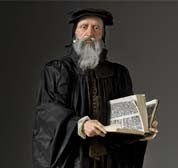Catechisms and Catechizing in England from 1530 to 1740

The following is an excerpt from the chapter Catechizing in Church in Ian Green’s The Christian’s ABC: Catechisms and Catechizing in England (1530 – 1740). It provides a fascinating look into how the English churches of that time catechized.
The attitude of the English church to basic catechizing was not very different from that of the mature Luther or Calvin in the stress that was put on the role of the minister. Luther did not abandon his earlier belief that parents had a duty to teach their children the basics at home, but by the time he published his shorter catechism, it was on the shoulders of the “faithful, godly pastors and preachers” that he put the main responsibility for teaching it. Calvin too thought that householders and school teachers had a role to play, but in the text of his 1541 catechism the exchanges were between minister and child, and in the ordonnances ecclesiastiques of the same year it was to the minister in the church at midday on Sundays that parents were told to bring their children to be catechized.
In England, too, while many bishops and enthusiasts envisaged a role for parents in instructing their charges, there is no sign of great confidence that they would play it, or of any official attempt to make instruction domestic compulsory. Instead, in England from the early stage the brunt of the burden of ensuring the basic catechism was mastered and understood, especially by those who never attended a school, fell on the parish clergy.
The official reliance on the clergy for basic catechizing was laid down in the rubrics of the Edwardian, Elizabethan, and Caroline Prayer Books and the canons of 1571 and 1604. Catechizing was to be performed by what the rubric in the original Book of Common Prayer called “the curate of every parish.” In the absence of assistant clergy in the majority of the parishes at this time, “curate” referred literally to the man with the cure of souls: the parson, rector, vicar, or perpetual curate, or minister as he was often referred to in later Episcopal injunctions and visitations articles.
Basic catechizing was to take place on those days when all the faithful were supposed to attend church: Sundays and those holy days retained by the Protestant church. However, it is worth noting that regular catechizing on a weekday was not unheard of ... according to Samuel Clarke, the puritan hagiographer, a number of godly clergy not only preached twice on Sundays but also catechized or gave a catechetical lecture on weekdays as well.
Being catechized in church was part of a process of growing up in a village or town in which community and congregation overlapped, and was, at least in theory, a means to the end of further participation in the rites of passage which (as parents knew full well) only the church could provide. And from the point of view of a highly perceptive child like William Wordsworth, there may have been a frisson of excitement about b eing catechized and an element of anticipation about being ‘bishoped,’ as an initiation rite into adulthood. By the eighteenth century (and sometimes earlier) there was also the prospect of a reward or treat for those who were confirmed. Such thinking may have made children accept, if not necessarily welcome, their parents’ insistence that they attend church for catechizing for a period of time.
By was of conclusion and comparison, a word may be said about catechizing in Presbyterian churches and separatist congregations from the 1650s. In the 1650s the exercise was certainly comparable to that in ‘church’...
For there were always many Presbyterians and other nonconformists who were anxious to catechize in public if they could. Hence the elementary catechisms prepared by men like John Owen, John Wallis, Richard Baxter, George Fox, Benjamin Keach, Isaac Watts, and others for their particular groups of catechumens.
There was also a comparable commitment to securing understanding as well as instilling knowledge, a growing variety of catechetical forms and methods, and some extremely zealous catechists, such as Richard Baxter, Henry Stubs, Thomas Wadsworth, Thomas Lye, Thomas Doolittle, Thomas Vincent, Philip Henry, and his some Matthew, Samuel Bourn the younger and many others. Thomas Lye’s thirty year ministry, mainly in London, was marked by his zeal for catechizing, and his unflagging attempts to find new ways to make the Westminster Shorter catechism easier to master and understand, especially by those with ‘weakest capacities and memories.’ He taught catechism publicly on Saturday afternoons at Dyers’ Hall in the mid 1670s and among those he instructed was a very young Edmund Calamy. Of Thomas Doolittle it was said that “catechizing was his special excellency and delight, wherein he took much pains himself, and which he earnestly recommended to his brethren in the ministry, as greatly tending to their people’s profit, and their own comfort.” By his own account, his normal catechumens ranged from 6 to 28 years in age, though he also tells us he had helped some in their thirties and forties, and up to their seventies. In the preface of an early venture, which turned the Shorter Catechism into a series of questions requiring yes and no answers, Doolittle recorded the delight that children found in this exercise: they “would with great willingness for an hour or two together, answer yes or no to the questions, and so may yours,” he added to the householders to whom the published work was dedicated.
--The Catechizer
Labels: Creeds Confessions and Catechisms, History




0 Comments:
Post a Comment
<< Home